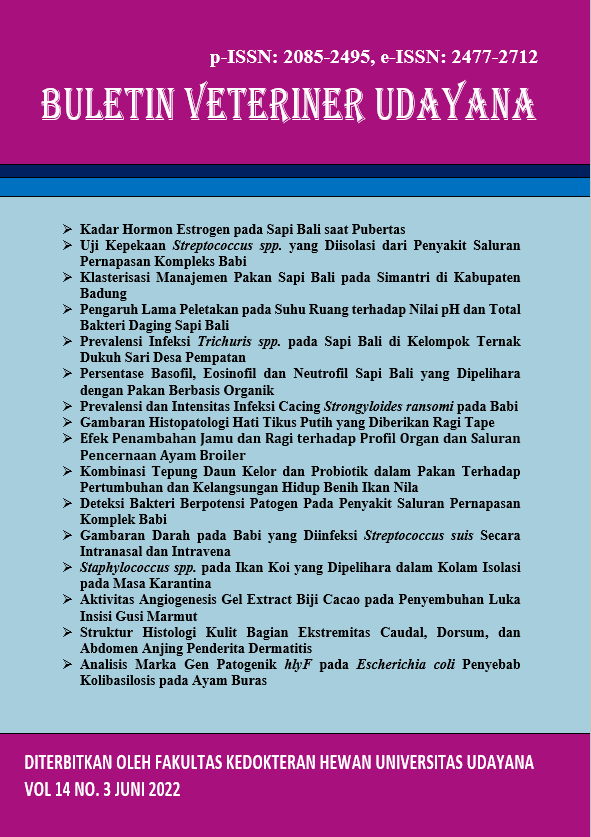SENSITIVITY TEST OF STREPTOCOCCUS SPP. ISOLATED FROM PORCINE RESPIRATORY DISEASE COMPLEX AGAINST KANAMYCIN, STREPTOMYCIN AND DOXYCYCLINE
Abstract
Respiratory diseases in pigs often occur in the production of modern pigs around the world and known as Porcine Respiratory Disease Complex (PRDC). Prevention of PRDC can only be done if the infecting agent is bacteria. The bacteria that are most often isolated in complex pig duct disease are Streptococcus spp. This study was conducted to determine the sensitivity pattern of Streptococcus spp. isolated from animals with PRDC symptoms on kanamycin, streptomycin and doxycycline. Isolates were taken from the results of the PRDC case study of pig origin in Tabanan, Gianyar and Badung regencies. Pure isolates were then planted in blood agar and a sensitivity test was carried out using the Kirby-Bauer method for each antibiotic. Bacteria can be resistant, intermediate and sensitive to antibiotics tested. This gives rise to a pattern of sensitivity to antibiotics so that resistant germs will cause treatment failure. The results showed that hemolytic ? Streptococcus isolates were 60% sensitive to kanamycin, 100% sensitive to streptomycin, 40% resistant to kanamycin and 100% resistant to doxycycline. While hemolytic ? Streptococcus isolates were 100% sensitive to kanamycin and streptomycin but 100% were resistant to doxycycline.
Downloads
References
Bochev I. 2007. Porcine respiratory disease complex (PRDC): A review. I. Etiology, epidemiology, clinical forms and pathoanatomical features. Bulg. J. Vet. Med. 3: 131−146.
Bousquet E, Morvan H, Aitken I, Morgan JH. 1997. Comparative in vitro activity of doxycycline and oxytetracycline against porcine respiratory pathogens. Vet. Rec. 141: 37−40.
Christina S. 2012. Streptococcus dysgalactiae: A Practical Summary for Controlling Mastitis. Virginia State University.
Dutkiewicz J, Sroka J, Zając V, Wasiński, B, Cisak E, Sawczyn A, Kloc A, dan Wójcik-Fatla A. 2017. Streptococcus suis: a re-emerging pathogen associated with occupational exposure to pigs or pork products. Part I – Epidemiology. An. Argic. Environ. Med. 24: 638-695.
EMEA. 2003. Committee for Veterinary Medicinal Product Kanamycin. The European Agency for the Evaluation of Medicinal Product Veterinary Medicines and Inspection.
Geffner SDE, Moreno MR, Campillo AMS, Pardo SFJ, Gómez GA, Martínez-Lozano MD. 2001. Streptococcus suis meningitis. An. Med. Intern. 18: 317–318.
Hannan PC, Windsor HM, Ripley PH. 1997. In vitro susceptibilities of recent field isolates of Mycoplasma hyopneumoniae and Mycoplasma hyosynoviae to valnemulin (Econor®), tiamutin and enrofloxacin and the in vitro development of resistance to certain antimicrobial agents in Mycoplasma hyopneumoniae. Res. Vet. Sci. 63: 157−160.
Kotra LP, Jalal H, Shahriar M. 2000. Aminoglycosides: perspectives on mechanisms of action and resistance and strategies to counter resistance. Antimicrobial Agents and Chemotherapy 3249–32560066-4804/00/$04.0010.
Marie J, Morvan H, Berthelot-Hérault F, Sanders-Kempf PI, Gautier-Bouchardon AV, Jouy E, Kobisch M. 2002. Antimicrobial susceptibility of Streptococcus suis isolated from swine in France and from humans in different countries between 1996 and 2000. J. Antimicrob. Chem. 50: 201−209.
MacInnes JI, Gottschalk M, Lone AG, Metcalf DS, Ojha S, Rosendal T, Watson SB, Friendship RM. 2008. Prevalence of Actinobacillus pleuropneumoniae, Actinobacillus suis, Haemophilus parasuis, Pasteurella multocida, and Streptococcus suis in representative Ontario swine herds. Can. J. Vet. Res. 72(3): 242-248.
[NCCLS] National Committee for Clinical Laboratory Standards. 2012. Manual of antimicrobial susceptibility testing. USA: Am. Soc. Microbiol. Pp. 1-241.
O’Sullivan T, Friendship R, Blackwell T, Pearl D, McEwen B, Carman S, Slavić D, Dewey C. 2011. Microbiological identification and analysis of swine tonsils collected from carcasses at slaughter. Can. J. Vet. Res. 75: 106-111.
Palmieri C, Varaldo PE, Facinelli B. 2011. Streptococcus suis, an emerging drug-resistant animal and human pathogen. Front. Microbiol. 2: 1-6.
Pratiwi S, Rahim A, Mirawati T, Ikaningsih S, Ariyani K, Hutabarat T, Suharto R, Sardjito, Subandrio A. 1999. Laporan tahunan hasil uji resistensi bakteri terhadap berbagai antibiotika. Laboratorium Mikrobiologi Klinik Fakultas Kedokteran Universitas Indonesia.
Priadi A, Natalia L, Poernomo S. 2004. Penyakit Glasser’s pada babi di Pulau Batam, Propinsi Riau. JITV. 9(4): 266-271.
Samsuri, Utama IH. 2001. Kepekaan Streptococcus equi sub spp. zooepidemicus terhadap antimikroba kanamisin, streptomisin, ceftriakson, dan danofloksasin. J. Vet. 2(4): 111-115.
Sharma D, Cukras AR, Roger EJ, Southworth DR, Green R. 2007. Mutational analysis of S12 protein and implications for the accuracy of decoding by the ribosome. J. Mol. Biol. 374(4): 1065-1076.
Soedarmanto I, Pasaribu F, Wibawan IWT, Lämmler C. 1996. Identification and molecular characterization of serological group C streptococci isolated from diseased pigs and monkeys in Indonesia. J. Clin. Microbiol. 34(9): 2201-2204.
Suarjana IGK, Widya A. 2012. Karakterisasi molekuler dan uji patogenesitas Streptococcus patogen isolat asal Bali. Bul. Vet. Udayana. 4(1): 1-8.
Suarjana IGK, Besung INK, Tono KPG. 2017. Detection of haemophilus parasuis from the respiratory tract of pigs. J. Vet. Animal Sci. 1(1): 11-14.
Syarif A, Purwantyastuti A, Suharti KS, Bahroelim B, Sulistia GG. 2013. Farmakologi dan Terapi. Edisi 5. Balai Penerbit FKUI: Jakarta.
Timmerman T, Dewulf J, Catry B, Feyen B, Opsomer G, de Kruif A, Maes D. 2006. Quantification and evaluation of antimicrobial-drug use in group treatments for fattening pigs in Belgium. Prev. Vet. Med. 74: 251–263.
Tsodikova SG, Labby KJ. 2016. Mechanisms of resistance to aminoglycoside antibiotics: overview and perspectives. Med. Chem. Comm. 7(1): 11-27.
Wertheim HFL, Nghia HDT, Taylor W, Schultsz C. 2009. Streptococcus suis: an emerging human pathogen. Clin. Infect. Dis. 48(5): 617-25.
Yeotaek C, Changin Oh, Kunkyu L, Ki-hyun C. 2017. Survey of porcine respiratory disease complex-associated pathogens among commercial pig farms in Korea via oral fluid method. Vet. Sci. 18(3): 283-289.





